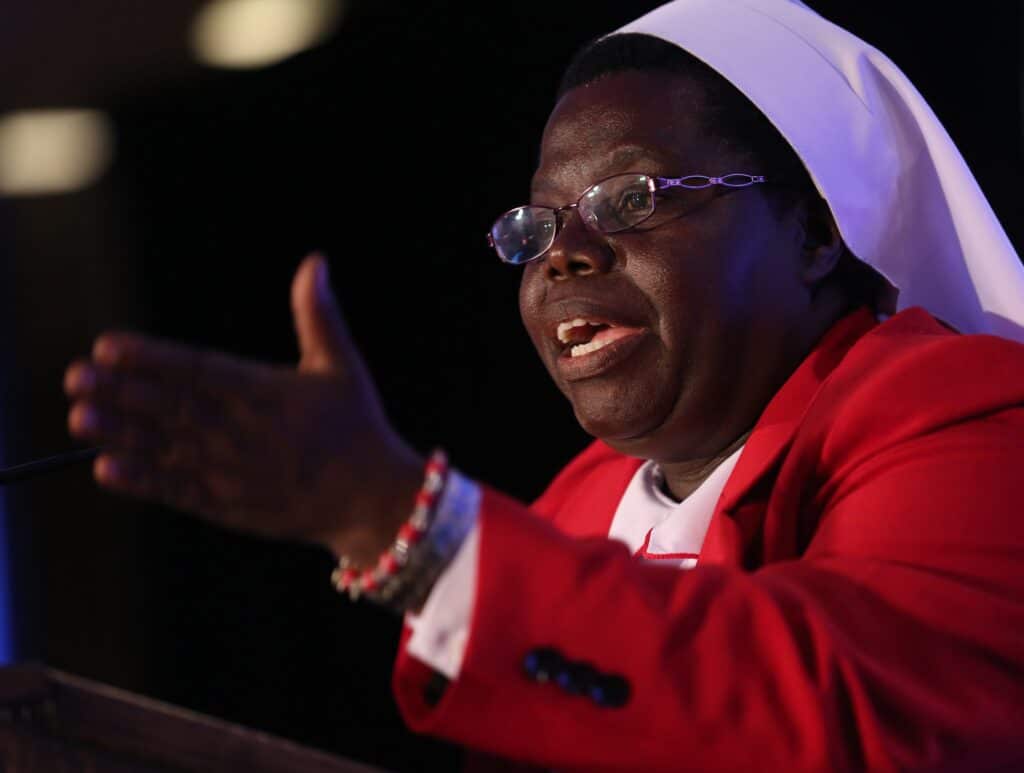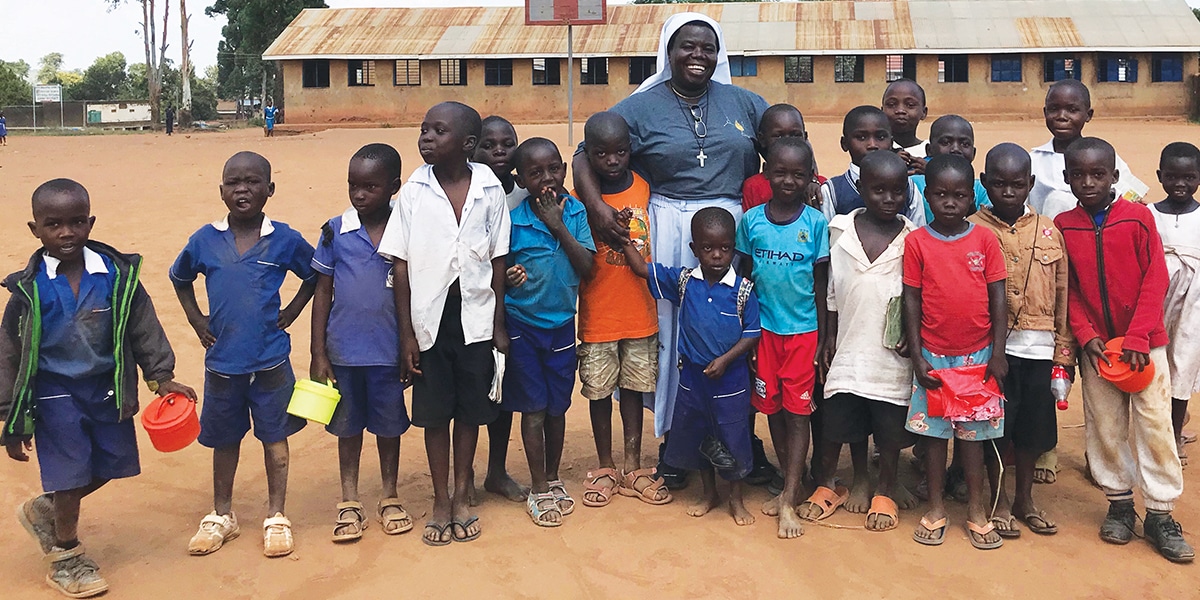She’s been featured in Time magazine and on CNN for her humanitarian work, but her faith, not fame, is what fuels her efforts to rescue abducted girls in South Sudan and Uganda.
She stops to chat with a barefoot teenage girl and her friend, each stitching away on a black manual Singer sewing machine. The girls are sewing on a small porch outside their classroom, hoping to take advantage of the cool Ugandan afternoon breeze. Something she says makes the student smile. The girl toys with the measuring tape hanging around her neck, then hands Sister Rosemary Nyirumbe the piece of material that she’ll be assembling into a shirt. It is clear as she looks over the student’s fabric that Sister Rosemary is checking every detail with the utmost attention. She is blunt but kind in her remarks to the teenager, who responds with a serious, “Yes, Sister, I understand, Sister,” before once again smiling at Sister Rosemary’s final words.
A Mission to Rescue Lives, Heal Souls
Best known as the driving force who saved hundreds of children from abduction during the bloody war that devastated northern Uganda and South Sudan for over 20 years, Sister Rosemary knows very well how essential it is for her girls to have pride in their work and in themselves because of the obstacles and suffering they’ve endured.
“We want these girls to know they are worth something. They are not begging or asking for money. They are learning a trade,” she emphasizes. “It is very important to have girls educated in order for them to be able to meet the challenges of the world tomorrow.”
In 2002, when then-46-year-old Sister Rosemary was first assigned to St. Monica’s Girls’ Tailoring Centre in the northern Ugandan city of Gulu, her homeland was immersed in a violent and destructive tribal civil war. Throughout northern Uganda, warlord Joseph Rao Kony and his militia, the Lord’s Resistance Army (LRA), battled government forces to rule over the region.
They regularly abducted children, forcing boys into becoming child soldiers and girls into becoming sex slaves for the militia. The LRA killed those who didn’t comply. Most estimates document over 30,000 children stolen by the LRA over the course of the war, although some list the number as high as 60,000.
Walking with a sense of purpose and always with joy, Sister Rosemary remains faithful to the mission of St. Monica’s to provide a safe home and education for victims of war and violence and, in particular, to orphans and young women.
“People may forget that people here continue to suffer,” notes the 62-year-old Ugandan sister. “Part of my effort is to tell the world not to forget, to try to stop this evil from happening again, and to let the girls know that the world cares about them.”
Living in the Spirit of Prayer
“That was a difficult time,” Sister Rosemary remembers. Terrified of being taken from their villages, children would walk the dirt roads to Gulu every evening, looking for protection. Sister Rosemary and the sisters took in every child, hiding them at St. Monica’s in any possible space, from storage closets to furniture—housing 300 to 500 children every night.
“During the war, I was struggling so much. We had nothing to feed these children we were hiding. I went to Rome, to the Community of Sant’Egidio, and begged them, ‘Please help me to feed these children.’ They immediately gave me money for food and to buy them mattresses, blankets, and other needs.”
Over time, it became evident to Sister Rosemary that the children—especially the girls—needed more than shelter and food. Boys who escaped the LRA militia were able to return home and go to school. But in Uganda’s tribal culture, girls who escaped—often arriving with their own children born of rape—were rejected by their families and unwanted by the community.

So Sister Rosemary started a day care for the little ones. And she started a literacy program for the girls. Then she began to teach them a trade, to empower their hearts and their will with vocations as seamstresses, cooks, or hairdressers.
When she first began, Sister Rosemary acknowledges, she felt helpless, not knowing what to do. Then you find out, the only thing you have which you can bring out is the little love you have in the heart—and then compassion is given. That opened my eyes, to accept them beyond what even they expected me to do.”
“When we open our arms and embrace these girls, they feel accepted. They become stronger and stand up straight!” She stops to smile. “You can see it in their faces when they feel broken. They don’t trust anybody. And so you have to be playful, show them a place of happiness, accept them back as they are.”
Ultimately, emphasizes Sister Rosemary, the temptation of asking people about their past is what kills all of us. “I remember thinking, Rosemary, close your lips. The father of the prodigal son did not ask where his boy had been. Instead, he threw his arms around him, embraced him, gave him new clothes, new rings. For me, that is a sign of life-giving. He gave life back to his boy.”
An Ongoing Crisis
According to the United Nations, child abductions in Africa continue. The United Nations’ child protection team notes, for example, that intertribal abductions are on the rise in South Sudan, Uganda’s northern neighbor, where a child is worth 20 cows or about $7,000. In Nigeria, western Africa, Boko Haram’s abductions of schoolgirls led to the international battle cry #BringBackOurGirls. Yet, four years later, over 100 of those girls are still missing.
The situation is different in northern Uganda, where the active abductions of children ended in 2006. Yet girls continue to escape from captivity in the bush. “Just last year, we had girls who came to us from captivity. This year, we have two girls who were born in captivity!” Sister Rosemary exclaims. “There was one who stayed with the rebels for nine years, then came to us at our school in Atiak. It was so hard to even connect with the feelings of this girl. She had no emotion. She kept saying, ‘No one cares about me.’ And we said over and over, ‘Estella, we care about you.’ You can still see the line of pain in her face, the line of suffering.”
St. Monica’s Girls’ Tailoring Centre in Gulu, home to 400 girls and young women, has enrolled more than 2,000 girls in the past 16 years. Sister Rosemary and her community, the Sacred Heart of Jesus Congregation, have expanded their work in the region, opening schools and centers in Moyo, Adjumani, and a 100-acre farm in Atiak, where they also serve women, children, and orphans fleeing from the current violence in South Sudan.
At the Sewing Hope Orphan Village in Atiak, located on the primary trade route between Uganda and South Sudan (only 22 miles south of the border), the teenage girls serve as models, even mentors, to the 50-plus younger students, most of them orphans, who live and attend school on the other side of the compound. A newly installed well provides them with fresh water, thanks to Father Jim Chamberlain and the University of Oklahoma’s WaTER (Water Technologies for Emerging Regions) Center project. As is true in most of Uganda, small solar panels outside every building and hut serve as a limited source of electricity.
Paradoxically, the school is near the location of the infamous Atiak massacre. In April 1995, soldiers in Joseph Kony’s LRA executed by gunfire approximately 300 civilians, kidnapping hundreds of young children from the village.
While the actual number of LRA members has varied over the years to as many as 3,000 soldiers, Kony’s militia is believed to have slaughtered over 100,000 people. Kony himself was indicted in 2005 for war crimes and crimes against humanity by the International Criminal Court in The Hague—but has never been captured.
Love Is the Key
Rosemary Nyirumbe, the youngest of eight children, was born and raised in a small village of huts with grass roofs within Paidha, West Nile, located so close to the Democratic Republic of Congo (DRC) that children cross the border to attend school in the neighboring country. It is 122 miles and over three hours away on dirt roads from Gulu, where Sister Rosemary now lives.
She laughs often, and heartily, as she explains how most members of her tribe, the Alur, are like her—short and robust—while their neighbors in Gulu, the Acholi, are lean and tall. Yet the same woman who jokes about her 5-foot stature has also shaken hands with foreign presidents, kings, and NBA stars. Rome Reports described her last year as “the Mother Teresa of Africa.”
She was one of Time magazine’s “100 Most Influential People in the World” in 2014. She is the subject of the book Sewing Hope and a 2013 documentary by the same name, narrated by Academy Award-winning actor Forest Whitaker. She received the United Nations Impact Award and has been named a CNN Hero. She even had a song written in her honor, “Touched by a Rose,” by JAIA.
But for “baby sister,” as her brothers, sisters, and family still call her, speaking engagements and awards are simply platforms to tell her story: “I have the great opportunity to speak on behalf of people who cannot speak for themselves.” The truth is that “I am not strong,” she adds, “so that keeps me dependent on God, praying to have energy, strength, and the right words to speak to each audience.”
She prays the same four-word supplication every day of her life, “Rwoth para, Mungu para [My Lord and my God]”—always spoken in her soul-language of Alur. “Love is the key for doing all the work we can do,” she clarifies, adding that Mother Teresa has joined the group of saints that she relies on because Mother Teresa’s calling was to do small things with great love. “Real love will always make you different.”
Sister Rosemary credits her love of children and the Italian Comboni sisters for her vocation, a call she answered at the young age of 15. Her community of over 325 sisters, in fact, grew out of the Combonis in 1976, when the Comboni missionaries encouraged them to form their own African community and elect the first African superior general.
With their motherhouse in Yuba, South Sudan, the sisters also live out their motto, “Live Love in Truth,” in Kenya and Uganda, where most Sacred Heart vocations come from. “I think the girls look at what we are doing, and they are attracted to it; they want to be a part of it. Every year, St. Monica’s sends girls to the convent.”
Prayer fuels Sister Rosemary’s every effort, seeking the Eucharist everywhere she travels. “I am dedicated to my rosary, even if I don’t complete it!” she laughs. “I’ve got a lot of devotion to Our Lady, which is strange because [as a Sacred Heart of Jesus sister] I should have more devotion to the Sacred Heart! Our Lady gives me answers very fast,” she says with a smile. “It’s good for me to be close to the Mother—it’s all among women!”
Her prayer before the Blessed Sacrament is simple, explains Sister Rosemary. Always with thanksgiving, “My prayer is, ‘Lord, you are with me, so if I go out in your name, let everyone I meet know that you are with me. I am thankful that you come to me, who is unworthy.'”
Sidebar: Taking Down Trafficking
In a March 2014 message to Brazilian Catholics during that country’s annual Lenten Campaign for Fraternity, Pope Francis said, “It is not possible to remain indifferent before the knowledge that human beings are bought and sold like goods!” The continuing and pernicious practice of human trafficking often involves forcing children to become sex slaves or child soldiers, such as in South Sudan and Uganda. Children forced into sexual slavery is a global problem that reaches well beyond developing nations. Some estimates have the number of child sex slaves around the world at 10 million.
But there are ways to get informed, donate, or help by other means to combat child sex slavery and trafficking, as well as other humanitarian issues.
- The United Nations International Children’s Emergency Fund’s website contains information on a plethora of issues facing children worldwide and includes a donate button on every page within their site.
- The United States Conference of Catholic Bishops’ website (usccb.org) has a page titled “Anti-Trafficking Program,” which provides a Catholic perspective on the issue of human trafficking, ways to make financial contributions to the Catholic Fund Against Human Trafficking, and a link to sign up for its monthly anti-trafficking newsletter, Amistad.
- Find out more about the University of Oklahoma’s clean-water initiative, the WaTER Center.








